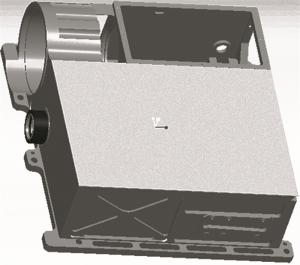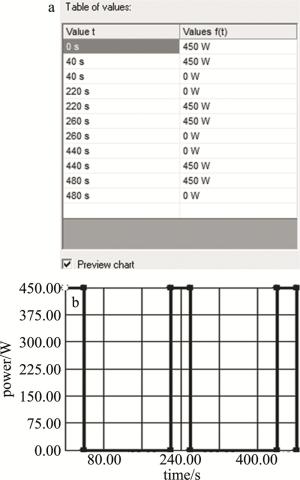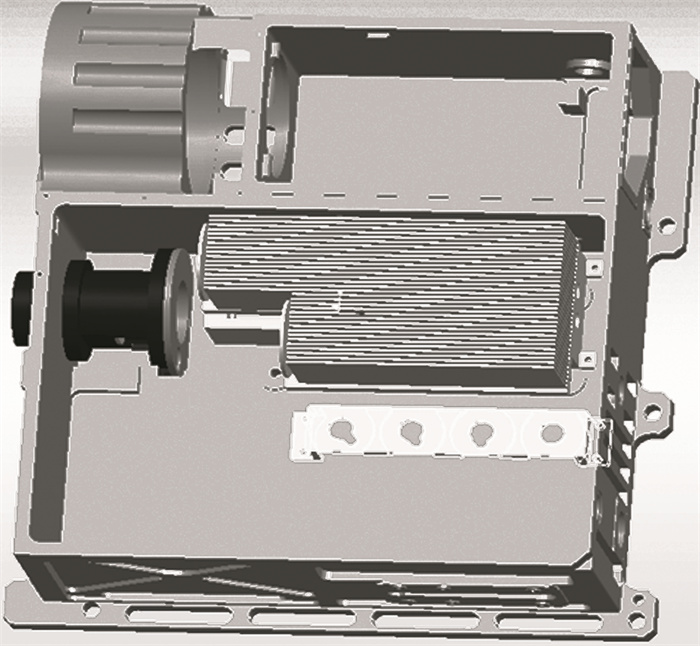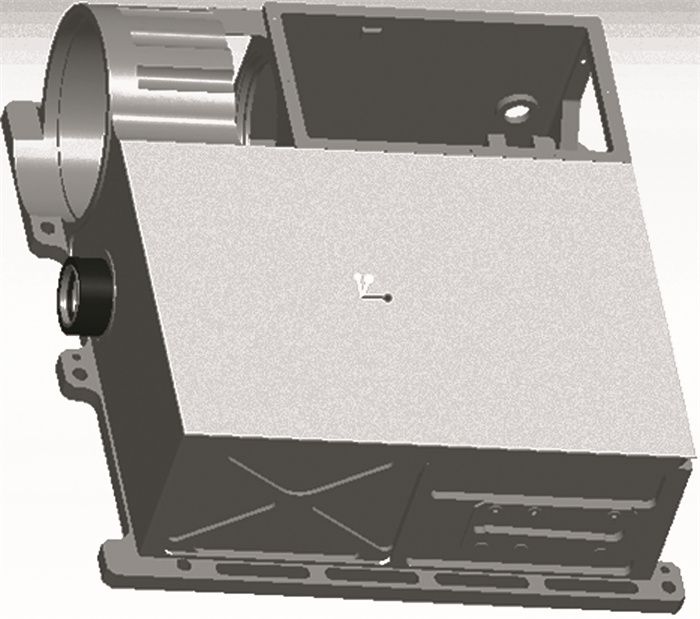HTML
-
二极管激光器的阈值电流是指激光器正常工作时的最小电流。激光器的结构和共振腔品质决定了温度对阈值电流的影响,具体如下式[4]所示:
式中,T0是特征温度,Iref是参考温度Tref下的阈值电流。从(1)式可看出,阈值电流会随着温度的升高而增大,为使激光器在较低的阈值电压下工作,必须提高热沉的散热效率,从而降低二极管激光器芯片的工作温度。
二极管激光器作为YAG固体激光器的抽运源,其热量主要是通过热沉散出。二极管激光器芯片产生废热依次通过焊接层、绝缘层、初级热沉、次级热沉最终通过对流产生的方式散出。二极管激光器芯片温度与传热热阻、冷却流体温度、输出功率的关系如下式[5]所示:
式中,Tlaser表示二极管激光器芯片的最高温度,Tc表示冷却流体的温度,Rth表示芯片与冷却流体件的传热热阻,I0和U0分别表示输入电流和输入电压,Pout表示激光器输出功率。由(2)式可知,要想降低二极管激光器芯片的温度要从两方面着手:(1)降低冷却流体的温度,增大温差以提高散热热流密度;(2)减小二极管激光器芯片与冷却流体间的传热热阻。本文中在假设这两者都是最优的情况下,次级热沉与外界散热部件进行热传导的设计与分析。
-
该二极管激光器的设计要求如下:波长为1.064μm;激光器输出能量大于150mJ;重频为50Hz;脉宽小于10ns;束散为2.5mard~3mard;工作温度为-30℃~+65℃。光束质量:光斑能量分布均匀;工作方式:重频50次/s时,一次连续工作时间不小于40s,间隔时间3min为一个工作循环,连续工作3个循环后休息30min。
该二极管抽运Nd∶YAG固体激光器的最高使用环境温度为65℃。YAG固体激光器使用的抽运源——二极管激光器(以下简称抽运源)工作温度为20℃~60℃。因此, 在65℃工作时,热管理条件最为严峻,产品的热设计的重点是产品如何满足环境温度65℃工作时保证巴条工作温度不大于60℃。
YAG固体激光器的热设计分为激光晶体的热设计和抽运源热设计[6-8]。激光晶体采用的是圆柱形YAG晶体棒,其热设计为传导冷却,YAG晶体棒侧面的一半为抽运面,另外一半铟焊在与之热胀系数一致的金属热沉上,其材料为钨铜合金座WCu20(GB/T8320-2003),该金属热沉再与激光器基体紧密接触,实现热传导冷却,其结构如图 1所示。
激光器抽运源热设计[9],采用半导体热电致冷器(thermo electric cooler, TEC)辅助温控的宽温度范围(20℃~60℃)巴条并结合轴流风机强迫风冷,TEC提高致冷效率的前提是最大限度地及时带走TEC热端的热量。抽运源金属热沉与TEC的冷端紧密接触并与激光器外壳进行绝热设计,TEC热端与外部散热部件——带散热翅的均温板紧密贴合,该均温板内部真空封装均热介质,以保证更高效的散热。风机对均温板的散热翅进行强迫风冷。在环境温度低于20℃时,即-40℃~20℃时,启动TEC加热巴条热沉到20℃之上时,TEC停止工作,当环境温度超过60℃时,启动TEC致冷,使得巴条热沉温度不超过60℃。一般情况下,在激光器工作的大部分时间是20℃~60℃,所以TEC不用工作,发热和功耗都维持在一个较低的水平。
-
该激光器采用两组抽运模块,每组抽运模块以25Hz交替工作,合成50Hz激光输出。每组抽运模块采用48×2个150W的二极管巴条交错对称抽运,每个巴条最大工作在100A、脉宽200μs下,则总的抽运脉冲峰值电功率和电脉冲能量分别为:2×96V×100A×200μs =3.84J,抽运功率为3.84×25=96W,以二极管40%的光电转换效率,巴条产生的热功率为96×60%=57.6W。
考虑到小型化、轻量化的设计要求,采用半导体制冷散热方式进行散热,其最主要的特点[10]是体积小、可靠性强、操作简单[11],通过调整TEC内部参量可以提高TEC的控冷效果[12],并且最佳的传热面积比值能让TEC特性系数达到最大值。在TEC冷热面不大于30℃的前提下,TEC效率为40%,此时TEC的功率为57.6/40%=144W,则TEC热端需要散走的热量为144W+57.6W=200W。
由于本方案中采用2组抽运模块,因此TEC热端散走的热量为200W×2=400W。
由风机强迫冷却散热翅盖板带走如此多的热量压力很大,尤其在65℃高温的小体积密闭舱里,更是艰巨,所以需要进行整机的详细热设计、仿真。
2.1. 激光器方案设计
2.2. 激光器热计算
-
本次热仿真采用FloEFD软件[13]。FloEFD是无缝集成于主流3维CAD软件中的高度工程化的通用流体传热分析软件,它基于当今主流计算流体力学(computational fluid dynamics, CFD)软件都广泛采用的有限体积法(finite volume method,FVM)开发,其完全支持本次3维设计软件——SolidWorks软件的计算机辅助设计(computer aided design,CAD)模型。FloEFD的分析步骤包括测距机3维模型建立、自动网格划分、边界条件施加、求解和后处理等完全在CAD软件界面下完成,整个过程快速高效。值得注意的是,已经通过大量数值验证该方法是正确的[14-16]。
-
采用SolidWorks软件进行3维建模,该机箱的模型比较复杂,在保证分析精度的前提下,需要对测距机的结构进行简化[17]。简化过程中,机箱的细节特征,如螺纹孔、工艺孔、圆角、倒角可去掉;装配体中的小零件,如盖板螺钉、加强筋等也可去掉。对于通风滤网,在保证通风面积不变的情况下,可以用包含一定风阻的结构代替。简化后的结构如图 2和图 3所示。
-
划分网格数量的多少会直接影响计算精度和准确性。虽然网格数目越多计算精度越准确,但与此同时计算规模也会随之增加,计算机的运算负担也就越重,运算所需的时间也就越长。因此, 在确定网格数量时需要平衡两方面,既要满足设计精度要求,又要避免计算机运算负担过重。
-
环境温度65℃;单个TEC外形尺寸:120mm×30mm×3.45mm;均温板外形:210mm×100mm×58mm,散热翅宽1.5mm,翅间距为1.5mm,翅高50mm,散热面积约为377580mm2;均温板导热系数为2500W/(m · K)。
机箱模块功耗如图 4所示。热耗等效为面热源,两组TEC热功耗共450W(考虑50W裕量),工作40s,停止3min,共3个循环。功率加载波形如图 5所示。
-
机箱内两个风扇分布位置如图 6所示。风机采用的是轴流式风机,其电压为28V,外形大小约40mm×40mm×28mm,单个风扇风量设置为恒定值50m3/h,共两个风机。
-
将以上的条件加载到模型上,仿真TEC与散热均温板贴合面的温度。该测距机的工作方式为:重频50次/s时,一次连续工作时间不小于40s,间隔时间3min为一个工作循环,连续工作3个循环后休息30min。可知,激光器热沉在40s,260s,480s时,温度达到峰值,这3个时间的TEC与散热均温板的温度云图如图 7所示。由图中可看出,温度最高的位置是两个TEC的位置,然后围绕最高温度位置,温度逐渐降低,温度曲线如图 8所示。3个时间的温度分别为82.3℃,83.6℃和83.7℃。
综上分析,TEC模块在3个工作循环后,巴条最高温度为83.7℃,小于85℃的设计要求,该热设计可满足激光测距机的要求。
3.1. FloEFD热仿真
3.2. 模型简化的说明
3.3. 网格
3.4. 机箱输入条件设置
3.5. 风扇设置
3.6. 仿真结果
-
根据设计图纸,加工出各个零件。在散热均温板与TEC贴合的位置涂抹导热硅脂,以保证两者能紧密贴合,更好地导热。二极管激光器在高温65℃工作时,根据技术要求工作40s,停止3min,一共进行3个循环,激光器能正常工作,在重频50Hz下,输出能量为155mJ,脉宽为10ns,激光束散为2.6mard,经过24h的高低温工作和48h的高低温存储后,光斑大小依然均匀,光束质量仍然稳定可靠。测试散热器的温度约为85℃,证明该热设计满足激光器散热需求,满足测距机性能和技术要求。

 Map
Map












 DownLoad:
DownLoad:






